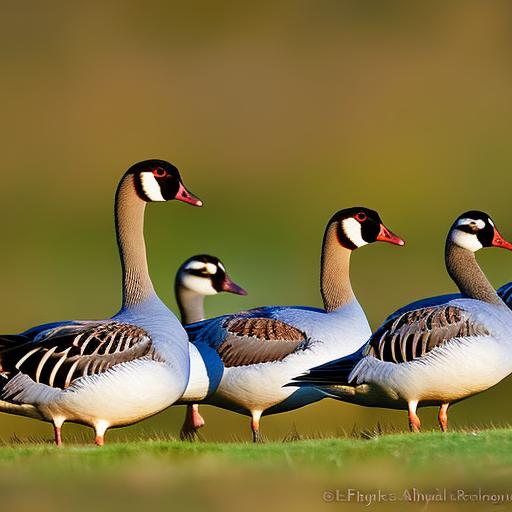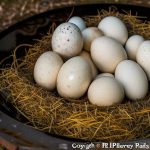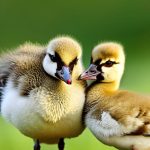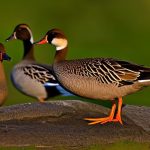Geese have been domesticated for thousands of years, with evidence of their presence dating back to ancient Egypt and Rome. They were initially domesticated for their meat, feathers, and eggs, but over time they have also become popular as ornamental birds. Geese are known for their strong instincts, loyalty, and ability to adapt to various climates and environments. Today, geese are still widely used in agriculture for their meat and eggs, as well as in ornamental settings for their beauty and grace.
Key Takeaways
- Geese breeds come in different varieties and are categorized based on their purpose.
- Popular breeds of geese include Toulouse, Embden, and Chinese geese.
- Different geese breeds have unique characteristics such as size, color, and temperament.
- Geese breeds for meat production include the Pekin and the African geese.
- Geese breeds for egg production include the Chinese and the Sebastopol geese.
Popular Breeds of Geese
There are several popular breeds of geese that are commonly found around the world. Some of the most common breeds include the Toulouse, Embden, Chinese, African, and Pilgrim geese.
The Toulouse goose is one of the largest domesticated breeds and is known for its calm and friendly temperament. It has a gray plumage with a white underbelly and is often used for meat production.
The Embden goose is another large breed that is primarily used for meat production. It has a white plumage and a gentle disposition, making it a popular choice for small farms.
The Chinese goose is a medium-sized breed that is known for its distinctive knob on its beak. It has a black or gray plumage with a white underbelly and is often used for both meat and egg production.
The African goose is a large breed that is primarily used for meat production. It has a gray or white plumage with a distinctive knob on its beak. African geese are known for their loud honking and protective nature.
The Pilgrim goose is a medium-sized breed that is primarily used for egg production. It has a gray or white plumage and is known for its calm temperament and ability to lay large quantities of eggs.
Characteristics of Different Geese Breeds
Each breed of geese has its own unique characteristics in terms of physical appearance, temperament, behavior, lifespan, and health issues.
In terms of physical appearance and size, the Toulouse goose is one of the largest breeds, weighing up to 20 pounds. It has a thick body and a broad chest. The Embden goose is also large, weighing up to 18 pounds, with a long neck and a sturdy build. The Chinese goose is medium-sized, weighing around 12 pounds, with a slender body and a distinctive knob on its beak. The African goose is also large, weighing up to 18 pounds, with a long neck and a knob on its beak. The Pilgrim goose is medium-sized, weighing around 12 pounds, with a compact body and a short neck.
In terms of temperament and behavior, the Toulouse goose is known for being calm and friendly. It is often used as a companion animal and can be easily trained. The Embden goose is also calm and gentle, making it suitable for small farms or backyard settings. The Chinese goose is known for being alert and protective, making it an excellent guard animal. The African goose is highly protective and can be aggressive towards strangers or predators. The Pilgrim goose is known for being calm and docile, making it suitable for families or small farms.
In terms of lifespan and health issues, geese generally have a lifespan of 10 to 20 years. However, some breeds may have shorter lifespans due to genetic factors or health issues. Common health issues in geese include respiratory infections, parasites, and foot problems. Regular veterinary care and proper nutrition are essential for maintaining the health and longevity of geese.
Geese Breeds for Meat Production
When it comes to meat production, there are several breeds of geese that are known for their high-quality meat.
The Toulouse goose is one of the best breeds for meat production. It has a large body size and a high meat-to-bone ratio, making it ideal for meat production. The meat of the Toulouse goose is known for its tenderness and rich flavor.
The Embden goose is also a popular choice for meat production. It has a large body size and a high meat-to-bone ratio, similar to the Toulouse goose. The meat of the Embden goose is known for its tenderness and mild flavor.
The African goose is another breed that is commonly used for meat production. It has a large body size and a high meat-to-bone ratio, making it suitable for meat production. The meat of the African goose is known for its tenderness and rich flavor.
While these breeds are excellent choices for meat production, there are some disadvantages to consider. These breeds require ample space to roam and graze, as well as proper nutrition and care to ensure optimal growth and development. Additionally, geese can be noisy and messy, which may not be suitable for all environments.
Geese Breeds for Egg Production
If you are looking for geese breeds that are known for their egg production, there are several options to consider.
The Pilgrim goose is one of the best breeds for egg production. It has a high egg-laying capacity, with some individuals laying up to 50 eggs per year. The eggs of the Pilgrim goose are medium-sized and have a rich flavor.
The Chinese goose is also a good choice for egg production. It has a moderate egg-laying capacity, with some individuals laying up to 40 eggs per year. The eggs of the Chinese goose are medium-sized and have a mild flavor.
While these breeds are excellent choices for egg production, there are some disadvantages to consider. Geese can be territorial and protective of their nests, which may require additional management and handling. Additionally, geese may not lay eggs consistently throughout the year, with peak production occurring during the spring and summer months.
Geese Breeds for Ornamental Purposes

Geese are not only valued for their meat and eggs but also for their beauty and grace. There are several breeds of geese that are commonly used for ornamental purposes.
The Sebastopol goose is one of the most popular breeds for ornamental purposes. It has a unique curly feather pattern that gives it a distinctive appearance. The Sebastopol goose is known for its elegance and grace, making it a favorite among bird enthusiasts.
The Pilgrim goose is also a popular choice for ornamental purposes. It has a sleek and compact body, with a distinctive black and white plumage. The Pilgrim goose is known for its calm temperament and ability to adapt to various environments.
While these breeds are excellent choices for ornamental purposes, there are some disadvantages to consider. Geese can be noisy and messy, which may not be suitable for all environments. Additionally, geese require ample space to roam and graze, as well as proper nutrition and care to ensure optimal health and well-being.
Geese Breeds for Pest Control
Geese are known for their strong instincts and protective nature, making them excellent candidates for pest control.
The Chinese goose is one of the best breeds for pest control. It has a loud honk and an alert nature, which can help deter pests such as rodents and snakes. The Chinese goose is also known for its territorial behavior, making it an effective deterrent against intruders.
The African goose is another breed that is commonly used for pest control. It has a loud honk and a protective nature, which can help deter pests such as rodents and snakes. The African goose is also known for its aggressive behavior towards intruders, making it an effective deterrent.
While these breeds are excellent choices for pest control, there are some disadvantages to consider. Geese can be territorial and may require additional management and handling. Additionally, geese may not be suitable for all environments, as they require ample space to roam and graze.
Geese Breeds for Conservation
Some breeds of geese are considered endangered or at risk of extinction, making conservation efforts crucial for their survival.
The Steinbach goose is one breed that is currently endangered. It is a small breed with a distinctive black and white plumage. The Steinbach goose is known for its calm temperament and ability to adapt to various environments. Conservation efforts are focused on preserving the genetic diversity of the Steinbach goose and promoting its sustainable breeding.
The Cotton Patch goose is another breed that is at risk of extinction. It is a medium-sized breed with a distinctive gray and white plumage. The Cotton Patch goose is known for its calm temperament and ability to adapt to various environments. Conservation efforts are focused on preserving the genetic diversity of the Cotton Patch goose and promoting its sustainable breeding.
Conservation efforts for endangered geese breeds are crucial for maintaining biodiversity and preserving the genetic heritage of these birds. These efforts include habitat restoration, captive breeding programs, and public education initiatives.
Geese Breeds for Crossbreeding
Crossbreeding geese breeds can result in offspring with desirable traits, such as increased meat or egg production, improved disease resistance, or unique feather patterns.
The Embden and Toulouse geese are commonly crossbred to produce offspring with a larger body size and increased meat production. These crossbred geese are known for their tender meat and high meat-to-bone ratio.
The Pilgrim and Chinese geese are commonly crossbred to produce offspring with a higher egg-laying capacity. These crossbred geese are known for their medium-sized eggs and consistent egg production.
While crossbreeding can result in desirable traits, there are some disadvantages to consider. Crossbred geese may not breed true, meaning that their offspring may not consistently exhibit the desired traits. Additionally, crossbreeding can result in reduced genetic diversity, which can increase the risk of genetic disorders or diseases.
Geese Breeds Pictures and Descriptions
1. Toulouse Goose: The Toulouse goose is one of the largest domesticated breeds, with a gray plumage and a white underbelly. It has a calm and friendly temperament, making it suitable for small farms or backyard settings. The Toulouse goose is primarily used for meat production due to its large body size and high meat-to-bone ratio.
2. Embden Goose: The Embden goose is another large breed with a white plumage and a gentle disposition. It is often used for meat production due to its large body size and high meat-to-bone ratio. The Embden goose is known for its calm temperament and adaptability to various climates and environments.
3. Chinese Goose: The Chinese goose is a medium-sized breed with a black or gray plumage and a white underbelly. It has a distinctive knob on its beak and is known for being alert and protective. The Chinese goose is used for both meat and egg production, as well as for pest control purposes.
4. African Goose: The African goose is a large breed with a gray or white plumage and a distinctive knob on its beak. It is primarily used for meat production due to its large body size and high meat-to-bone ratio. The African goose is known for its loud honking and protective nature.
5. Pilgrim Goose: The Pilgrim goose is a medium-sized breed with a gray or white plumage. It has a calm temperament and is known for its ability to lay large quantities of eggs. The Pilgrim goose is primarily used for egg production but can also be kept as an ornamental bird.
For more information on geese breeds, their characteristics, and their purposes, you can visit websites such as the American Livestock Breeds Conservancy or consult books on poultry farming and ornamental birds.
Geese breeds play a significant role in agriculture and ornamental settings. They are valued for their meat, eggs, feathers, and beauty. Different breeds have different characteristics, including physical appearance, temperament, behavior, lifespan, and health issues. Some breeds are better suited for meat production, while others are more suitable for egg production or ornamental purposes. Geese breeds can also be used for pest control and conservation efforts. Crossbreeding geese breeds can result in offspring with desirable traits, but it also has its disadvantages. Overall, geese are fascinating creatures that deserve our attention and appreciation for their contributions to agriculture and conservation efforts.
If you’re interested in geese breeds and want to learn more about them, you might also enjoy checking out this article on Poultry Wizard’s website. They have a fascinating collection of geese breeds pictures that showcase the beauty and diversity of these magnificent birds. From the majestic Toulouse to the elegant Chinese Swan, you’ll be captivated by the stunning visuals. To explore these captivating images, click here: https://poultrywizard.com/keeping-chickens/geese-breeds-pictures.
FAQs
What are geese breeds?
Geese breeds refer to the different types of geese that exist. There are over 20 breeds of geese, each with unique physical characteristics and temperaments.
What are some common geese breeds?
Some common geese breeds include the Toulouse, Embden, Chinese, African, and Canada Goose.
What do geese look like?
Geese have long necks, webbed feet, and broad bills. They come in a variety of colors, including white, gray, brown, and black.
What are geese used for?
Geese are used for a variety of purposes, including meat, eggs, feathers, and as pets. They are also used for weed control in some agricultural settings.
What is the temperament of geese?
Geese can be aggressive and territorial, especially during breeding season. However, they can also be friendly and social with humans if they are raised from a young age.
What is the lifespan of geese?
Geese can live up to 20 years in captivity, but their lifespan in the wild is typically shorter due to predation and other factors.
What is the difference between male and female geese?
Male geese, also known as ganders, are typically larger than females and have a more prominent neck and head. Females, also known as geese, are usually smaller and have a less pronounced neck and head. Males also tend to be more aggressive during breeding season.
Meet Walter, the feathered-friend fanatic of Florida! Nestled in the sunshine state, Walter struts through life with his feathered companions, clucking his way to happiness. With a coop that’s fancier than a five-star hotel, he’s the Don Juan of the chicken world. When he’s not teaching his hens to do the cha-cha, you’ll find him in a heated debate with his prized rooster, Sir Clucks-a-Lot. Walter’s poultry passion is no yolk; he’s the sunny-side-up guy you never knew you needed in your flock of friends!







